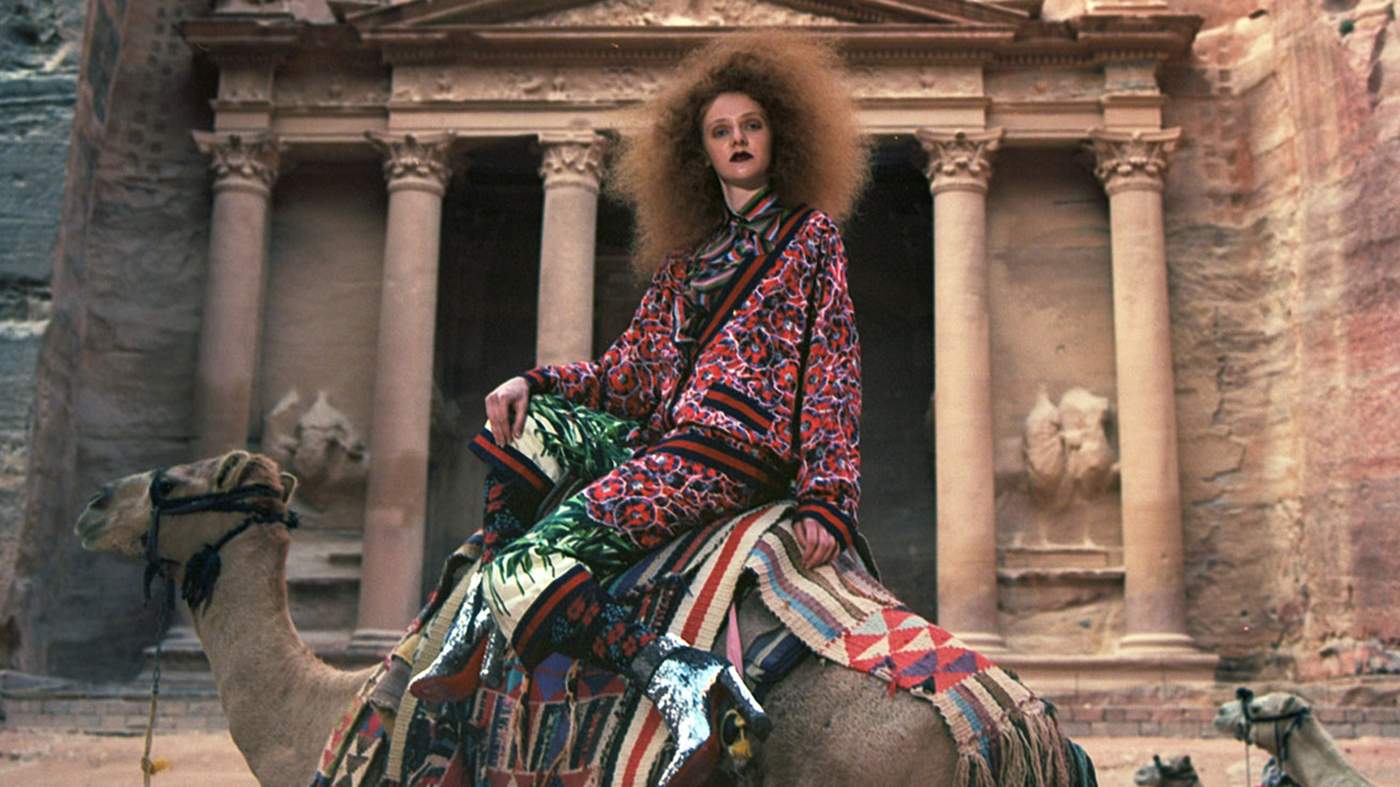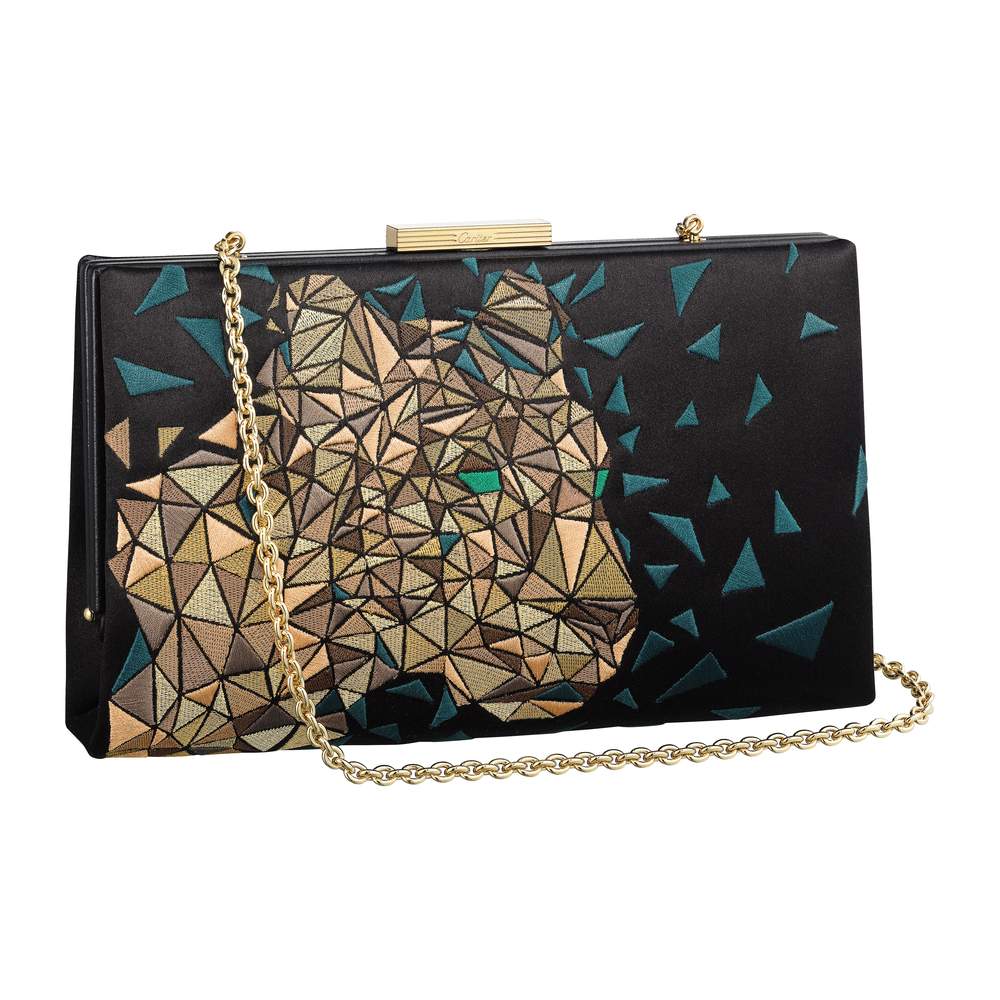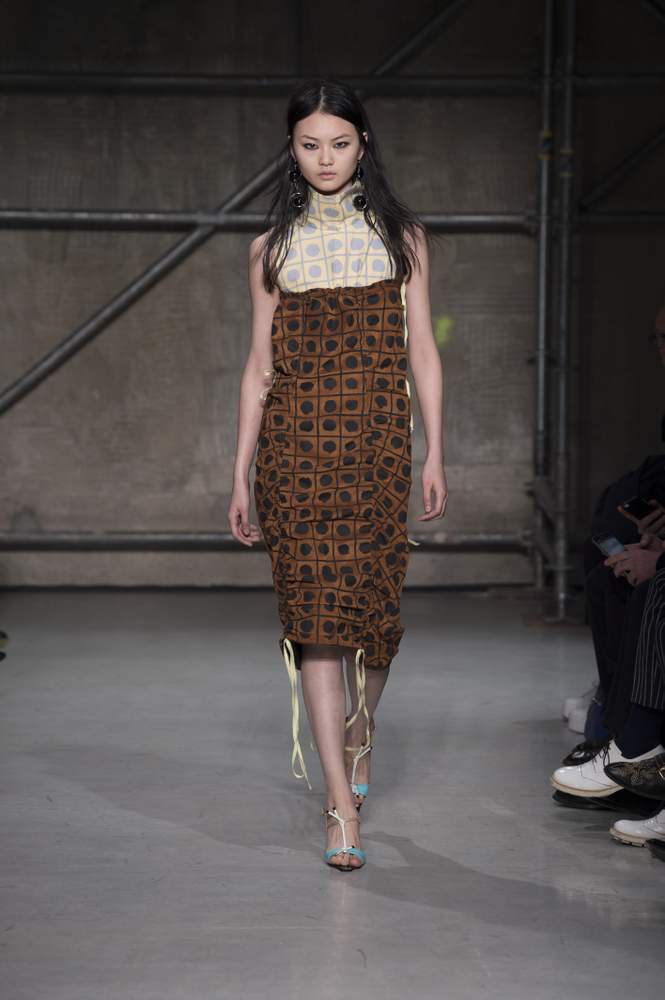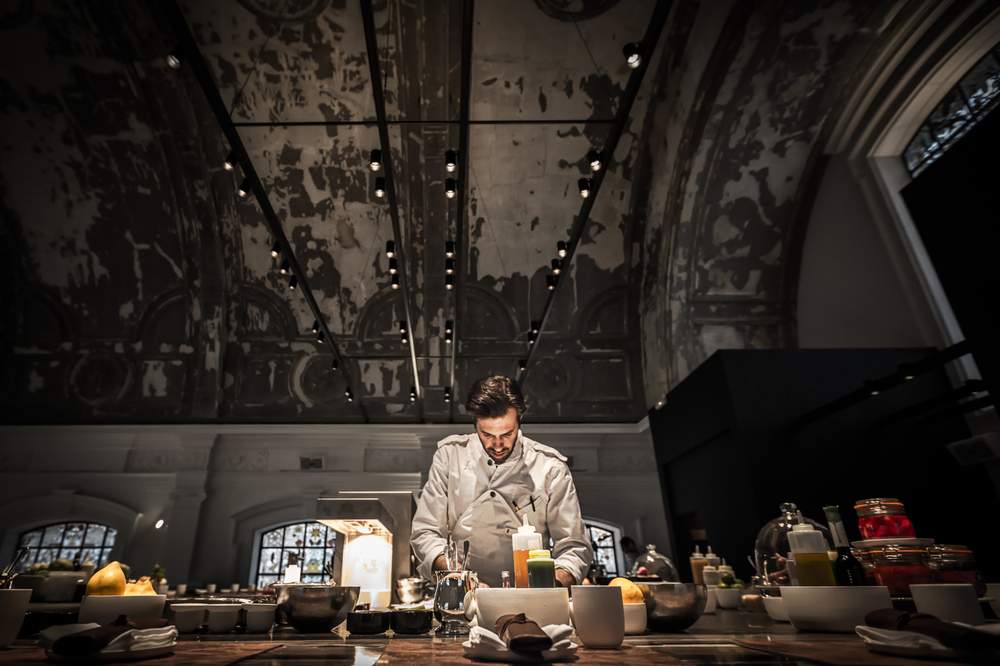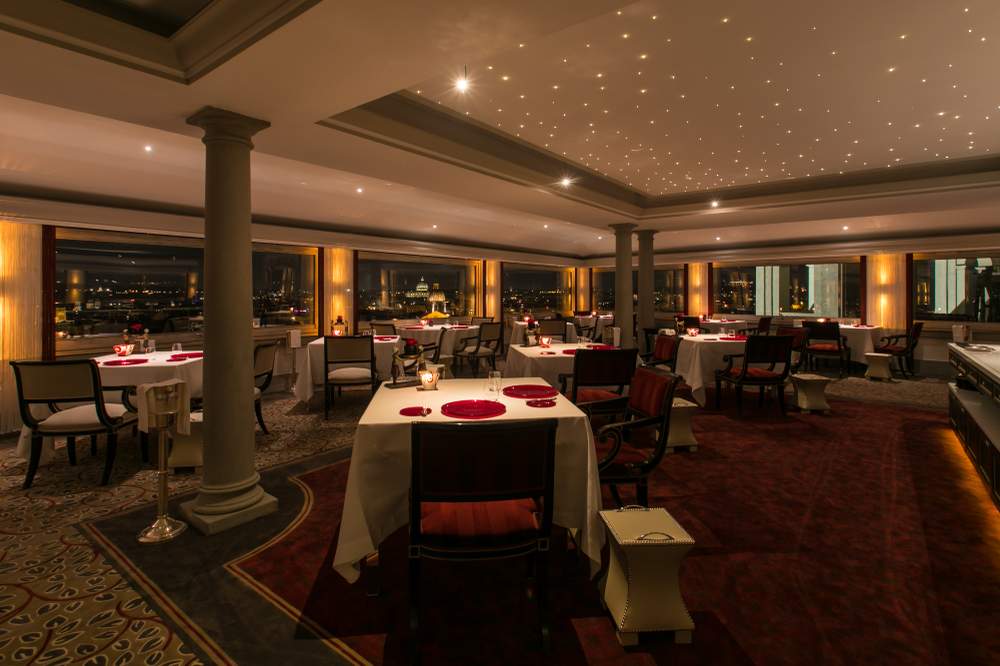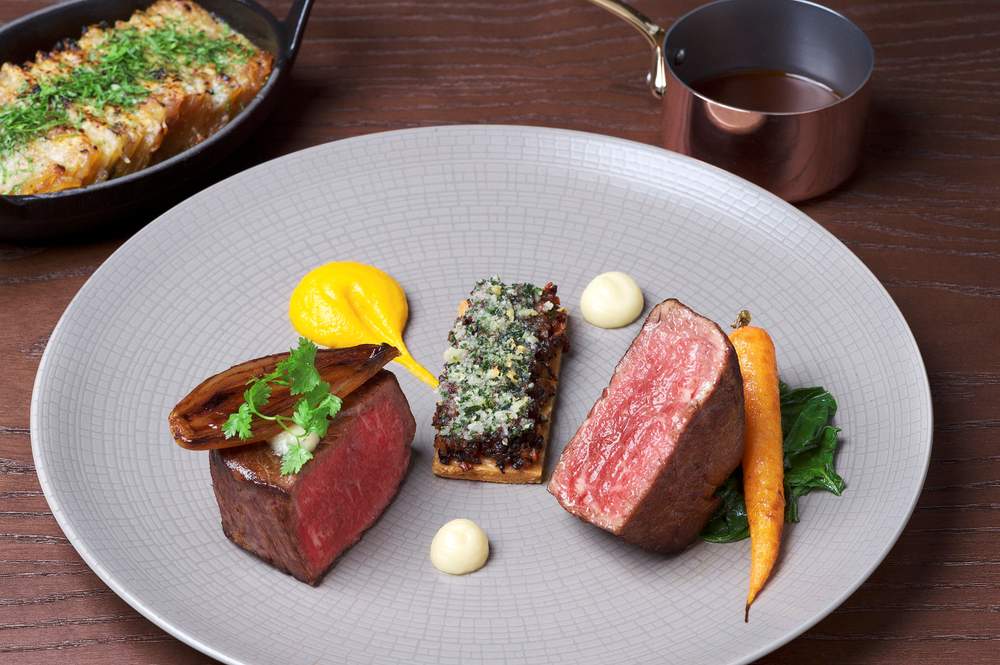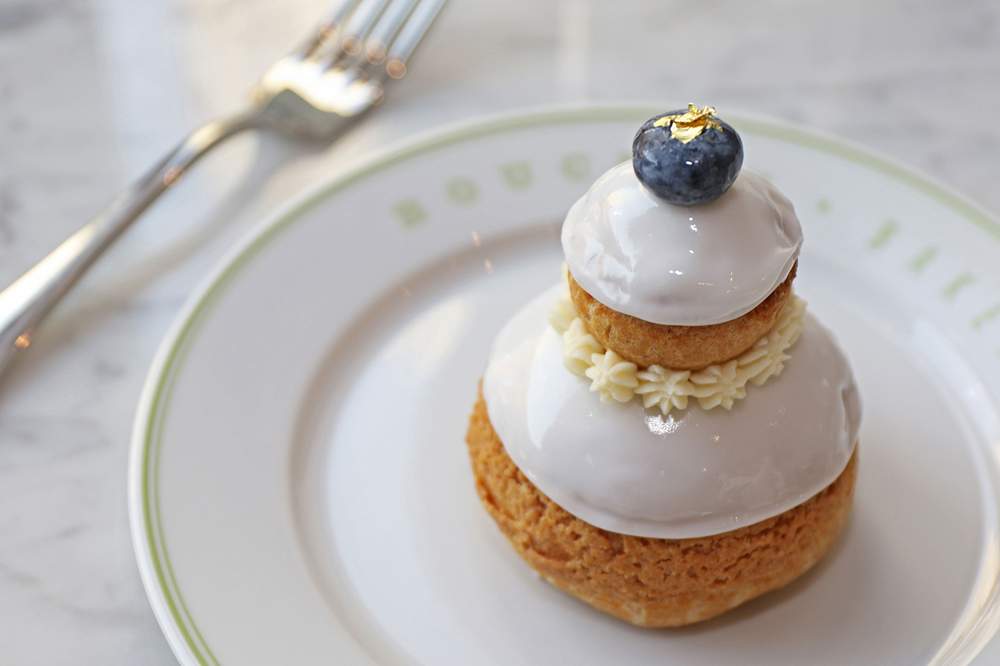A cut above
Selina Denman watches on as the largest D flawless diamond in the world is sold at auction for a record amount
Even in the rough, it was clear that this stone was something special. “Normally, there are black points, or cracks, or something,” Fawaz Gruosi, founder of the Swiss jewellery brand de Grisogono, tells me. “Whereas this was flawless. I quickly realised it was going to be something that hadn’t been seen before.”
He is referring to 4 de Fevereiro, a 404.20-carat rough diamond named for the day it was discovered, February 4, 2016, in Angola’s Lulo mine. It was the largest white rough diamond to be found in Angola, and the 27th largest in the world.
The stone was acquired by de Grisogono via Dubai-based diamond trading company Nemesis International and, tellingly, this is the same word that Gruosi uses to describe it. “I thought, a year and a half ago, that I had done everything in my career,” he says. “I couldn’t see what else there was. And then came my nemesis, this chance to create a new kind of treasure. It’s a lesson that, in life, anything can happen. You never know.”
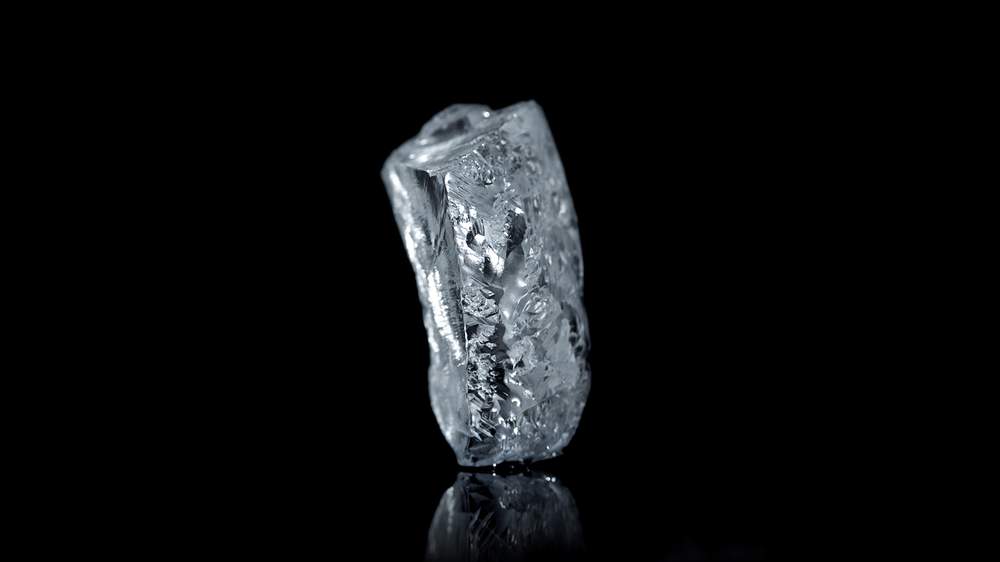
The 404.20-carat rough stone
The stone was first unveiled by de Grisogono in May 2016, at the Cannes Film Festival (where, Gruosi says, he kept picking it up and holding it, “for luck”). From that point until it was sold at a Christie’s auction in Geneva last month, it became his raison d’être.Leading experts from around the world were enlisted to help retrieve the best possible cut. And after nine months of intensive analysis, scanning, mapping, cutting and polishing in New York and Antwerp, Gruosi was left with a truly exceptional gem: a 163.41-carat, D-colour, flawless, emerald-cut diamond that, on November 14, became the largest of its kind to be sold at auction.
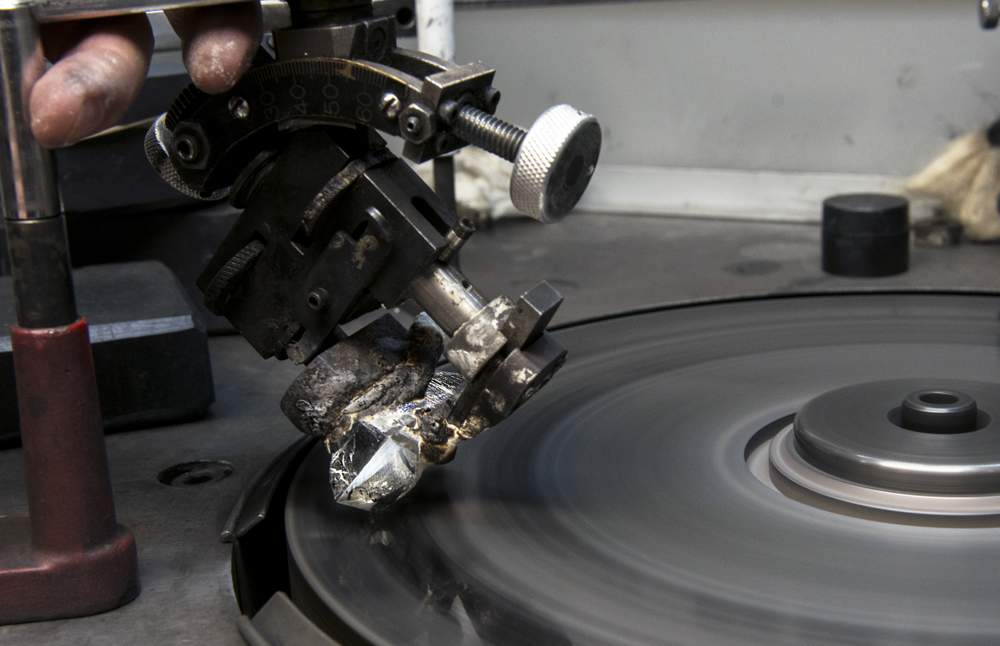
Mapping, cutting and polishing took nine months
I am presented with the stone in a private room in Geneva’s historic Four Seasons Hotel des Bergues. It is weighty, substantial, and sits snug in my palm. Like a cut-glass domino, its clarity is almost impossible for the eye to comprehend. These are sentiments shared by Tom Moses, executive vice president of the Gemological Institute of America (GIA). “Even though we grade and test most of the important diamonds in the world, to see something this special is truly exciting, even after decades of doing this,” he said when he first saw the gem. “I’m sure it will go down in the archives as one of the more important diamonds in history.”
Gruosi affectionately refers to the stone as a “she” and admits that once he had her in his possession, he felt a heavy weight of responsibility. His creative process is normally instinctive and spontaneous, he says (and anyone familiar with de Grisogono’s colourful, unconventional creations will know this to be true). But it was different this time around.
“Any idea that comes into my mind that I like, I implement immediately. Here, she stopped me. She was the only one that stopped me. I started to be a little nervous. The responsibility of that stone was huge. How to be really different? There are a lot of other jewellers who have had big stones, but have just paired them with a small chain or something like that, and I didn’t like that. That is not the point of being a jewellery designer.”
It is true that many other jewellers would have been so humbled by the stone that they would have introduced minimal adornment. But that has never been the de Grisogono way. Instead, Gruosi opted to dress it up further.
He came up with 50 potential designs and, in the end, settled on a necklace that pairs the diamond with a sweeping chain featuring 66 pear-cut emeralds, framed by almost 6,000 brilliant-cut emeralds, on one side, and 18 emerald-cut diamonds, set amid a further 863 brilliant-cut diamonds, on the other. “You can see the amount of work here – it’s 1,700 hours, which is totally insane,” says Gruosi proudly.
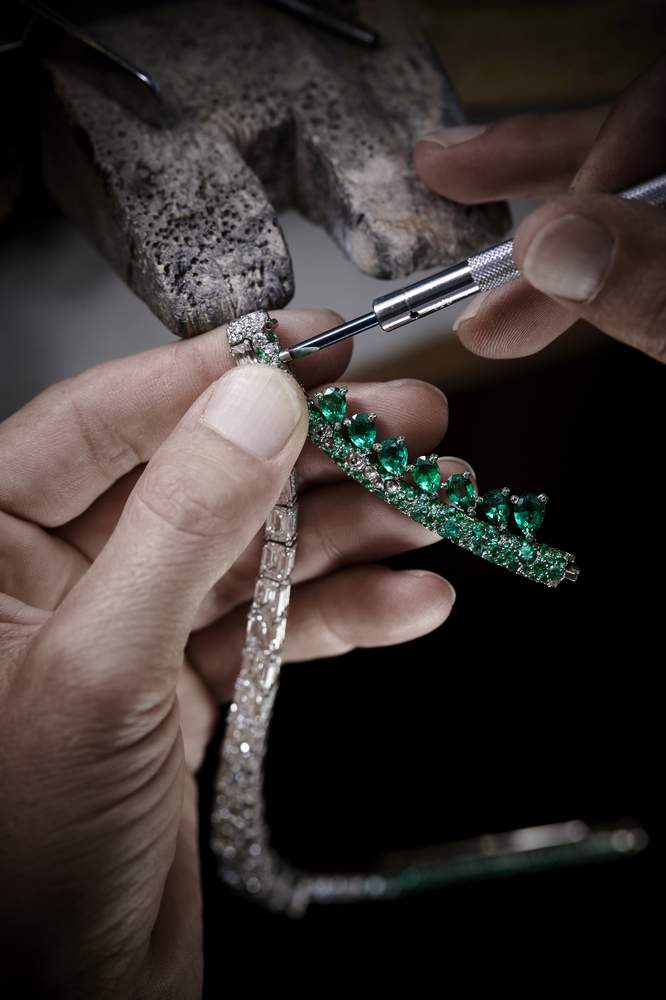
Creation I took a total of 1,700 hours to make
He’s right; the level of detail and intricacy is insane. And there’s a further twist: the diamond is fully detachable, and can be removed from the necklace to be placed on an oversized cuff, making “it something that can be worn every day”, says Gruosi. It speaks to the audacity that lies at the heart of the de Grisogono brand that Gruosi imagines that a 163-carat diamond can be worn casually “with jeans and a shirt”.I see him a few hours before the auction is set to begin. He looks tired – the anticipation must be weighing on him. If the sale is a success, Creation I will become Gruosi’s legacy, a culmination of his life’s work and an emblem for the brand that he has built from scratch. As it is, this ambitious undertaking is already a strong statement of intent – a way for a relatively young house (de Grisogono was founded 25 years ago, which is a mere drop in the ocean when compared to the centuries-old legacies of some of the world’s best-known jewellery brands) to finally take its place at the upper echelons of the industry.
I ask him how his stress levels are faring. “Ask me in a few hours,” he retorts with a wry smile. The brand has been tight-lipped about how much it expects Creation I to sell for and, when I look, Christie’s has not published an estimate – but Gruosi lets it slip. “Between US$30 million and $40 million [up to Dh147m],” he reveals.
Bidding begins at 9pm that day, in the ballroom at the Four Seasons. The room is full and hot under temporary spotlights that have no doubt been rigged up to ensure that Rahul Kadakia, international head of high jewellery at Christie’s and tonight’s auctioneer, can see all the action on the floor. De Grisogono’s tie-up with Christie’s is a stroke of genius. Founded in the 1700s, the auction house is as established as it gets – and offers a final layer of validity and legitimacy to Creation I’s story. Also, as Gruosi points out, it gives his brand a chance to speak to a new, much broader, audience.There are more than 200 objects in the Christie’s sale, and Gruosi’s necklace is last but one to go under the hammer. Bidding starts at a respectable 20m Swiss francs (almost Dh75m); just over three-and-a-half minutes later, Creation I has a new owner – and has set a world record for a D flawless diamond sold at auction, garnering CHF33.5m (Dh125m), including the buyer’s premium.“I think it was in line with where we thought the stone was going to go and I am happy to see that there was a bit of healthy competitive bidding in the room and on the telephones,” Kadakia says when I catch up with him straight after the auction.“It’s a very impressive piece, even for someone like me, who is in the jewellery business. When you look at Creation I, the combination of the necklace, the size of the diamond – it is perfection in terms of its colour and purity – the cut, the faceting. That in itself is very impressive; then you have the scale and the design of the piece.
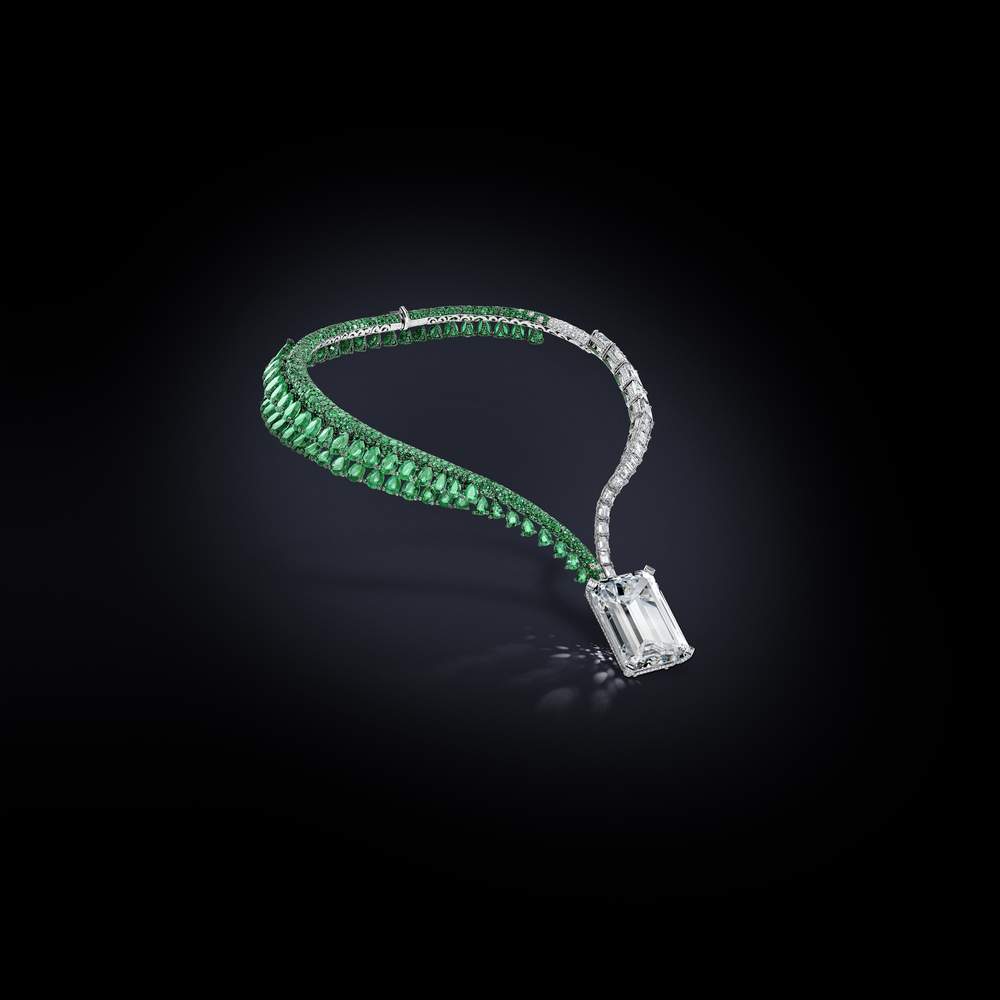
The end result, Creation I
“All of this combines into a great object, a work of art, almost, which is why it is aptly called Creation I,” Kadakia continues. “All in all, it was a good evening. There were healthy prices and a room full of clients; everyone was happy, so we were very happy with how things played out.”I am not entirely sure that Gruosi is happy as he heads out of the room – the expression on his face would suggest otherwise. I wonder if he is, on some level, relieved to be parting ways with his nemesis. And, in truth, even if the price is not quite what he would have liked, the gamble pays off. The next day, news sites around the world are telling the story of a one-of-a kind necklace that sold for a record amount – in the process, establishing de Grisogono as a brand that is unashamedly bold, in both its designs and its ambitions.
Why vinyl record is back in the loop
Lengthy beards and waxed moustaches, checked shirts, tattoos, fixed-gear bicycles, Buddy Holly glasses, vintage shoes and 35mm film cameras with manual frame winders – love them or loathe them, hipsters have brought all these things, and more, back into vogue over the past few years. And no self-proclaimed non-conformist would even dream of listening to their Portishead or LCD Soundsystem albums on compact disc or – shudder – digital download. For trues hipsters, only polyvinyl chloride records will pass muster.
But a resurgence in the popularity of vinyl cannot be explained away as simply being a part of the hipster movement. There has to be more to it than being cool, otherwise we would have already seen sales of vinyl records peak and die away. By contrast, by the end of this year, the music industry expects global vinyl sales to top US$1 billion (Dh3.7 bn) for the first time since their 1980s heyday.
Vinyl records can now be picked up in super-markets, and there are more of them on the shelves of Virgin Megastores in the UAE than there are CDs (in fact, many staff in electronics stores here have no idea what a compact disc player is). Which means, anyone with a desire to experience high-quality high fidelity has to seek out specialist audio dealers where sound is treated very seriously indeed.
Before you dismiss these stores as purveyors of money-wasting devices that add very little to your listening pleasure, consider this: what you listen to your music on can be compared to a car – a Rolls-Royce or a beat-up Nissan will get you where you want to go, but the experiences they deliver couldn’t be more different. So while we might think that MP4s downloaded in seconds to our smartphones are the way forward, the quality of the audio is often very poor, compared to how artists and their producers actually want us to hear it.
That comes down to compression of digital data. A smartphone or tablet device can store thousands of songs, along with information such as titles and album artwork. But if those audio files were the size they needed to be for perfect sound, our devices wouldn’t be able to hold more than a few dozen. And that compression usually becomes apparent when we play digital sound files through our home hi-fi equipment, which tends to highlight distortion at low volumes, a lack of depth or definition, as well as murkiness that simply shouldn’t be there.
Many of us are eager to spend huge sums of money making sure the visual aspect of our home entertainment is as good as it can get, with ultra-high-definition televisions and Blu-Ray players, but when it comes to sound, we’re generally happy to accept lower standards. Yet, the beauty of vinyl records is in the way they sound and, if you want to really hear what the musicians, performers, and their engineers and producers intended you to, there really is only one option – at least according to brothers Amir and Adil Anwar, owners of Dubai Audio, and Sound & Design in Abu Dhabi.
Having set up the business 23 years ago, they have carved a reputation in the region as leading experts in all things audio, but their hearts remain defiantly analogue. Enter either of their two main stores (they also operate a number of satellite outlets within some of the bigger malls), and prepare to change the way you appreciate not only music, but your sense of hearing, too. As dealers and distributors of the world’s highest quality audio systems, for the Anwar brothers, the return of vinyl is to be celebrated – but, they caution, these recordings must be played through decent sound systems in order to be truly appreciated.
Like almost any luxury product, there are sound- and home-theatre systems that can cost more than the average house but, as Adil points out, you “don’t need to go crazy to own an exceptionally good set-up.” A Linn Sondek LP12 turntable is awaiting delivery to a client, having been adjusted to its new owner’s requirements. “Look,” says Adil, as he pushes down on the circular surface. “It’s perfectly sprung and weighted. Everything is engineered to enable the most perfect sound reproduction. This is the most successful turntable in history and is, for many audiophiles, the absolute benchmark.”
Amir adds: “The external design hasn’t changed much over the decades, but the mechanical and electrical parts under the surface have gradually evolved as the technology has allowed. An owner of an LP12 that’s 20 years old could have theirs upgraded if they so wished – this is equipment that can and should last a lifetime.”
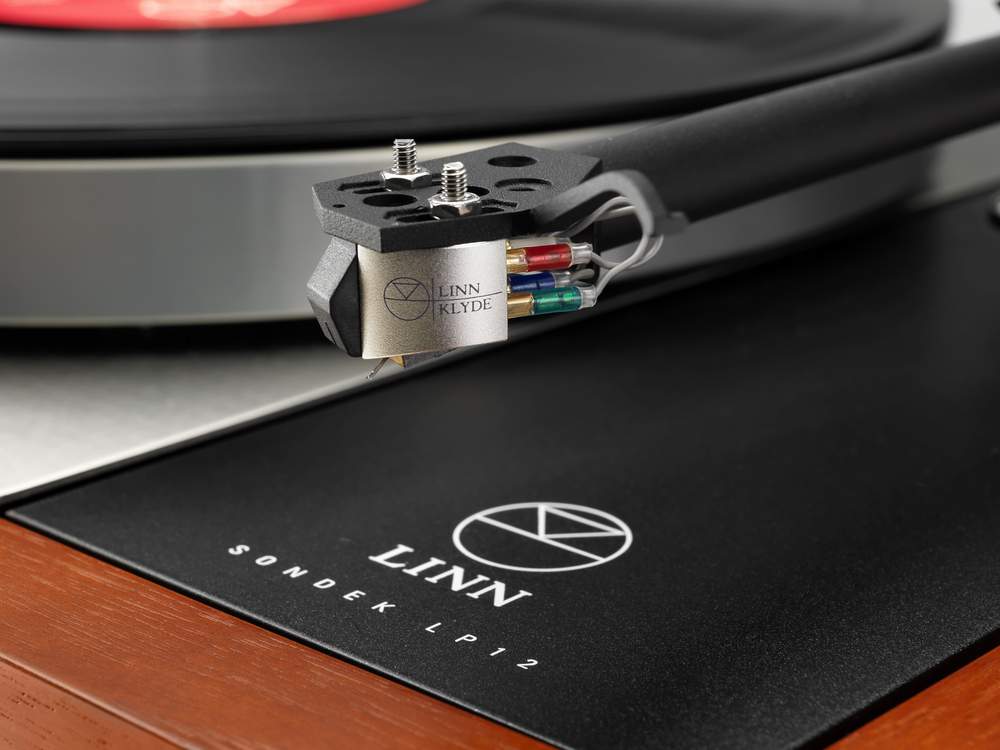
The Linn Sondek LP12 turntable, above, is one of the best on the market and is popular with audiophiles for its crystal-clear sound output
The brothers say that, for people serious about their music, vinyl never went away – it just became more difficult and more expensive to source. “When CDs were introduced,” recalls Adil, “there were lots of untruths stated by audio companies that wanted everyone to buy into that new technology. Reports that vinyl records wear out after a few plays, and statements about CDs offering perfect sound quality, were nonsense. True hi-fi enthusiasts never bought into that, but obviously recent services like Spotify and iTunes offer a convenience that you don’t get with 12-inch records.”
In a listening room in the brothers’ flagship showroom in Dubai, a reasonably priced system has been set up – the turntable, a Clearaudio Concept, would retail at about Dh5,000. We take a seat and Adil pulls Steely Dan’s classic 1977 album, Aja, from its sleeve, placing it onto the exposed platter, while reminiscing about how bands such as these put their hearts and souls into a sonic excellence that most of us have been missing out on for decades.
As the music starts, all else vanishes from the mind as warm, crystal clear sounds wash through the small room. Each instrument shines through the mix with a clarity that defies description. The bass punches through with force, but isn’t overpowering, while the vocals, drums, cymbals and jazz guitar layer over each other without crowding the overall sound. We’re left mesmerised by the production quality of an album that’s nearly as old as the UAE itself.
“Albums such as this were made to be played on vinyl,” enthuses Adil, “and it’s the only way for us to experience the true beauty of their art, even today.” We pick up the gatefold sleeve – the tactical joy of holding a physical record, of reading the lyrics and production notes, while admiring the large-format art of the cover, cannot be overstated. There’s a feel, a smell to vinyl records, that’s utterly unique.
The vinyl revival may well plateau before long and, admittedly, sales will never come close to the various digital platforms most of us enjoy. But as millennials and their succeeding generations grow older and come to appreciate true quality more, they are bound to embrace the unique pleasures that are afforded by the vinyl long-player. It never really went away, and hopefully it never will.
“Steve Jobs might have sold the MP3 to the world,” smiles Adil, “but when he went home, he listened to his music on a Linn turntable.” Enough said.
* Kevin Hackett
A flair for fragrance
The flamboyant Roja Dove chats to Panna Munyal about scents and sensibilities at the Dubai launch of his latest creation
Roja Dove is, above all, a master storyteller. Lauded with the moniker “professor of perfume” by the Guerlain family, whom he worked with for two decades, the British-born Dove is a leading expert in his field, an acclaimed bespoke perfume maker and founder of the most commercially successful brand ever to be retailed at Harrods in London. And yet, he says that becoming creative ambassador for Great Britain in 2013 remains the greatest honour of his working career.He tells the tale of how this came about in trademark Dove style: a manner that’s eloquent, absorbing and interjected with whoops of mirth, his eyes twinkling to match the multiple diamonds that sit on his fingers. “Imagine you’re sitting at your desk on a regular day at work, and you’re told there’s a call for you from 10 Downing Street. So you pick up the phone and, if you’re me, you say: ‘Hello, Roja Dove here.’ And they say: ‘We’re calling from Downing Street and we’d like you to come along. Oh, and you need to bring your passport.’ Lovely. So we fixed the time and I went there, got past security and, suddenly, I found myself walking up to this very famous door that I’ve seen all my life on the television. And all that was going on in my mind was: do you ring, or do you knock?”What ensued, says Dove, was surreal. Not only was he declared creative ambassador, but invitations to the upcoming launch of one of his perfumes in New York were sent out on royal stationary, with the then consul general to the Queen playing host at the event. “That was the first time that the honour of the title became a reality. The fact that the work you do makes a difference to your country is really fantastic,” he says.The work he is talking about involves formulating between four and 12 one-of-a-kind perfumes a year; conducting courses to train and guide emerging perfumers; as well as creating more standard, but no less special, scents under the Roja Dove label that he founded in 2011. The latest of these, Elysium, launched in the UAE last month.The sparkling glass bottle may say “pour homme”, but Dove is quick to align himself with the unisex trend that is infiltrating the world of modern perfumery. “More of my perfumes are unisex than not. I make no products that say ‘for women’ because, generally, for women around the world, if they like something, they are confident enough to use it. I’ve always loved that women are much more self-assured. Many men need to see ‘for men’ on the bottle, otherwise they don’t feel quite so secure.”As astute declaration indeed, which Dove backs up with more of his delightful insights. “Having gender on perfume is a Victorian concept, a time when women were not supposed to have opinions or, indeed, sensual desires; they were considered delicate. This might explain why they were named after flowers, Rose, Lily, Violet, Marigold, and that decided what their perfumes should smell of. The idea of what makes a masculine scent – woods, mosses and spices – comes from the idea of men being earthy, the whole woodland-predator thing,” Dove maintains.
“But one of the great things about modern perfumery is that we go back to this idea of scents being genderless, and more about what suits your personality. Interestingly, in the Middle East, most men don’t care about what they wear. If they like a smell, they put it on, which I think is fabulous.”
Dove’s ties with the region stretch far beyond his admiration for its “progressive people”. He credits the UAE for introducing him to oud, an ingredient he has since used in almost a dozen perfumes; and he opened the first-ever stand-alone Roja Dove boutique in Oman. “When I am introduced to clients from here, they often ask me: ‘How do you know our smell?’ And that’s a very interesting turn of phrase, and a great compliment, I think. I tell them it’s because I used to spend two weeks every three months of the year in the region, and that I got very, very close.”
In fact, he has even created a series of perfumes dedicated to the Gulf, including one that is called the United Arab Emirates, which is a rich and sophisticated scent that mixes oud with vibrant notes of rose and saffron. Many of Dove’s bespoke clients, too, hail from the Middle East. “Creating a scent for someone is a very intimate process, because perfumes have the power to both bring back memories and to create new ones.” He says that clients often compare a session with him with to going to a shrink, because of all the questions about their personal preferences and childhood references.
Dove also comes up with scents for people’s homes, offices and even their boats, based on the ingredients contained in the perfumes they wear. For instance, you can isolate specific notes in the perfumes you favour, in-store, and then burn these in your home, to sublimate, or dilute, the scent. This means your spaces will not smell exactly the same as you do, but will still carry the key notes that you respond to.
“Think of it like having a beautiful ring. You are the precious stone at the centre, and it is the job of the scented candle to work like the jewel’s setting; you don’t want it to shine more than you. A lot of people don’t stop to consider the effect of a smell, which is where I come in,” Dove explains.
That effect is greatly influenced by the quality of the ingredients, an area that Dove is actively involved in. The freshness of Elysium, for example, comes from a rare lime that exudes a woody aroma. He also included a special musk – a note that usually sits at the base of a perfume, but this is the only one in the world that works as a top note, he says. In addition, Elysium contains the elusive Rose de Mai. “It’s my signature material,” he explains. “It comes from Grasse in the south of France, and only blooms in May. An entire year’s production of this rose is less than a day’s production of the Bulgarian rose. And it’s in every single perfume I make.”
Details, then, are what drives Dove forward. Each perfume, bespoke or otherwise, is contained in a hand-polished bottle in a hand-made box. And each scent tells a story. “With the Gulf range, it was the concept of a mirage – the idea that these beautiful buildings [the Burj Khalifa on the United Arab Emirates perfume bottle] emerged from what was, until recently, nothing but desert. With Elysium, I imagined a star burst, one that both radiates light and draws you in. And every time you spray it on, I want you to imagine a supernova and go ‘ta-da’,” Dove concludes, with an exuberant flourish of his sparkling hands.
A palatial stay
Palazzo Versace Dubai presents a new way to experience the artful opulence that the fashion brand is best known for, says Selina Denman
Versace’s iconic Medusa head logo is a constant companion at the Palazzo Versace Dubai hotel. Her face is printed onto key cards, embroidered onto pillowcases and bathrobes, etched into shower doors, and picked out in mosaics on the swimming pool floor. The mythological character was chosen by Gianni Versace because whoever set eyes on her was subsequently unable to escape; he hoped consumers would respond to his creations in much the same way. In the hotel, the emblem becomes a clear statement of intent – the property is an extension of the Versace lifestyle proposition, and intended to be every bit as opulent and appealing as the brand's clothing and accessories.
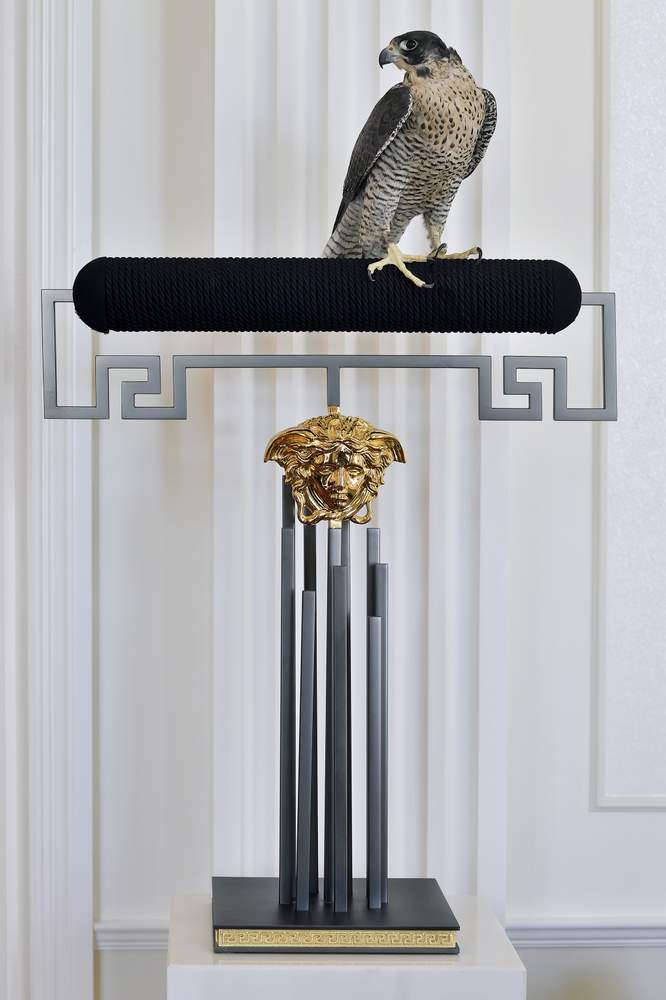
“For me, Palazzo Versace is the most incredible vision of the Versace world that we have yet to create. It is everything that I adore – craftsmanship, sophistication, energy and a passion for total luxury in life,” Donatella Versace told us when the property was officially opened just over a year ago, with a lavish party that welcomed the likes of Helena Christensen, Natasha Poly and Alessandra Ambrosio.
Modelled on a 16th-century Italian palace and interspersed with Arabian-influenced architectural elements, the imposing triple-fronted property sits statuesquely on the shores of the Dubai Creek. Its lobby is exactly what you would expect – neoclassical-style furniture is set on floors crafted from Italian Cremo Delicato marble; textiles look like they have been transposed directly from the Versace runway;colonnades call to mind ancient Roman ruins; and a grand chandelier, consisting of an incredible 3,000-kilograms-worth of hand-blown Bohemian glass, cascades from a ceiling that has been hand-detailed in gold.
The hotel’s location in Dubai’s Culture City holds a certain novelty value – it feels like you have escaped into a hidden corner of the city that no one else knows about. The views reinforce this idea; instead of looking out over the oft-seen skyline of new Dubai, the Palazzo Versace offers views out across the Creek towards Garhoud, Deira and, in the far distance, Sharjah, presenting a less familiar and more authentic perspective of the city. A respect for both the past and the present defines the property, and the Versace brand as a whole, said Donatella, and this was a big part of why Dubai was selected as the location for Versace’s second hotel (the first is to be found on Australia’s Gold Coast).
“Dubai is the perfect city to make this dream come to life,” said Donatella. “It is one of the most exciting cities on the planet. It represents a deep respect for tradition and a total obsession with the future. This mix of tradition and the future is also what defines the Versace world.”
Donatella’s stamp is apparent on every inch of the 215-room hotel. Sketches of designs from her Atelier Versace haute couture collection line corridors, while her actual creations can be acquired in the hotel's boutiques, which stock Versace-branded clothing, jewellery and homeware.

“I love to design pieces for interiors,” Donatella explained. “It is a different way of thinking than when I am designing for the catwalk. There is a timelessness to interiors that I love. I always think about what happens when people are experiencing the Versace life. I think about how people feel when they wear our clothes. I also think about how they will feel in our hotels, surrounded by this extraordinary craftsmanship and splendour. I want people to have the best time of their lives at Palazzo Versace. I want them to experience pure joy.”
Nowhere is this more apparent than in the hotel’s 65 suites. In the Executive, Grand Executive and Grand suites, parquet flooring is paired with a canvas of beautiful boiserie, and decorated in a stunning palette of turquoise, blue, beige, gold and salmon. Bedspreads are silken and sumptuous, while headboards are elaborate and intricately carved.

Located on the ninth floor, the hotels signature Suites measure up to 300 square metres and feature an entrance hall, powder room, living room and bedroom with an en-suite bathroom. Luxurious design touches include Cremo Delicato, Giallo Siena or Verde Laguna marble on the floors and walls dressed with intricate wallpapers.

This Versace-inspired opulence comes to a natural conclusion in the two Imperial Suites located on the top-floor of the Palazzo Versace. Set over two stories and measuring 1,200 square metres each, with a grand marble staircase connecting the two levels and acting as an anchor for the design, the Imperial Suites feature a dining room, living room, office area, lounge and entertainment rooms, private gym and sauna, as well as a master bedroom with walk-in closets.

The highlight of the space, however, an outdoor terrace that is home to a private pool and garden area. One of the suites carries a traditional, neoclassical design, while the second offers a contemporary aesthetic, courtesy of a more neutral colour scheme and furnishings from Versace Home’s understated Via Gesu collection.

The hotel is currently offering a special winter offer, inviting guests to experience the “Versace lifestyle” for as little as Dh1,250 per night. Valid until April 2018, the offer includes accommodation, complimentary transfers to Nikki Beach Resort & Spa Dubai, and a free shuttle service to The Dubai Mall, Dubai Festival City and Dubai Parks and Resorts. In addition, guests are eligible for discounts of 20 percent at the hotel’s restaurants and on massages at the spa, so they can fully immerse themselves in every inch of this luxurious, fashion-infused environment.
This month's names, numbers & events of note
Jazz in the dunes
Parisian band Swing Deluxe will perform at Qasr Al Sarab Desert Resort by Anantara from December 28 to 30. The band, who formed in 2003, specialise in tunes that fuse French and American jazz classics, particularly those from the 1930s, 40s and 50s. In Abu Dhabi, they will be performing covers of songs by artists such as Frank Sinatra, Duke Ellington, Boris Vian and Charles Trenet. To complement the performance, the resort will be laying on an opulent Bedouin-style dining experience, served under the stars among the dunes of the Liwa Desert’s Empty Quarter. The performance will last from 7pm until 10.30pm, and packages for the dinner and music cost from Dh498. Reservations can be made by emailing fbsecqas@anantara.com qasralsarab.anantara.com/jazz-in-the-dunes
Zegna’s Toyz
In time for the festive season, Ermenegildo Zegna has launched Zegna’s Toyz – a line of contemporary gift ideas fashioned from Pelle Tessuta, a woven leather fabric made from extremely thin strips of nappa hide. The collection consists of gadgets, devices and home accessories “dedicated to the modern man for three different moments in his life”. The Essential line includes travel accessories and business-related items, such as a cardholder and sunglasses case; Toyz includes games, such as playing cards and a dominoes set; and Technological features multimedia items, such as speakers and headphones that have been created in collaboration with premium audio brand Master & Dynamic. The collection is available from Zegna stores and via its website. www.zegna.comBulgari LvceaBulgari has unveiled two new handcrafted Lvcea timepieces composed of miniature gold tiles. The result, says Bulgari, is “an infinite variety of subtly shimmering light effects achieved by the meticulous placing of the tiny tiles in a long and patient process”. The wristwatches feature approximately 700 tiny squares of 18K gold plate, each measuring exactly 0.84mm. Each tile is individually applied to the dial, starting from the centre and working outward. Under each tile is a grain of sand, creating a slight obliqueness, which is responsible for the shimmering light reflections and for making each watch utterly unique. As if all this artistry weren’t enough, 78 brilliant-cut diamonds are applied to the face, making these pieces as valuable as they are special. www.bulgari.com
Gucci Bloom
The first Gucci fragrance to be developed under the expert nose of Alessandro Michele is now available in the UAE. Gucci Bloom was blended by master perfumer Alberto Morillas, in accordance with Michele’s wishes, which were to capture the richness of scent, as experienced in a thriving garden. “The garden is as beautiful as women are; colourful, wild, diverse, where there is everything,” Michele says. The ingredients used in its formula are nothing if not diverse: natural tuberose harvested in India, along with jasmine bud extract and Rangoon creeper – a unique flower that is used here for the first time in perfumery – combine to form a rich fragrance that, Gucci says, “transports the wearer to an imaginary garden”. As a final feminine touch, the lacquered bottle comes in a vintage powder pink. Gucci Bloom costs Dh545 for 100 millilitres. www.gucci.com
Korloff
Abu Dhabi-based admirers and collectors of Korloff, the luxury French jewellery and watch brand, no longer need to travel to get their fix. The brand, which was founded in 1978, is renowned for its feminine, intricate designs and its signature women’s collections, which include Envolées Poétiques and Lumière, can now be found at Al Manara International Jewellery stores within The Galleria, Yas Mall, Al Ain Mall, Marina Mall and Abu Dhabi Mall. www.korloff.fr

